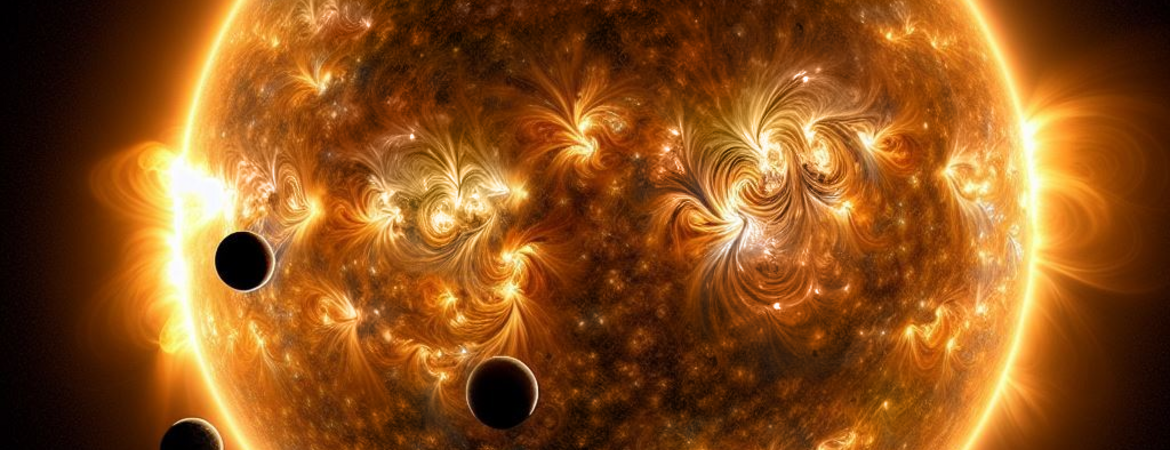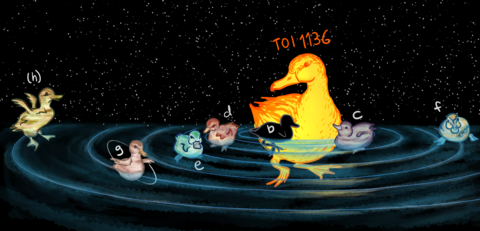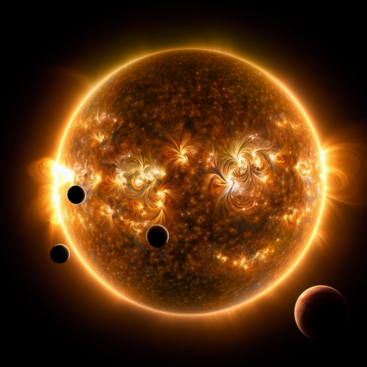
With an arsenal of advanced technology, scientists have found a multi-planet star system that provides a rare insight into the way planets form and behave around a young star.
TOI-1136 is a dwarf star in the Milky Way galaxy more than 270 light years from Earth, which is considered nearby, as the Milky Way is 100,000 light years in diameter. There are six confirmed planets orbiting the star, and scientists strongly suspect the presence of a seventh.
“Because few star systems have as many planets as this one does, it’s getting close in size to our own solar system,” said Tara Fetherolf, visiting assistant professor of astrophysics at Cal State San Marcos and co-author of a new paper about the system. “It’s both similar enough and different enough that we can learn a lot.”
Published today in The Astronomical Journal, the paper offers precise measurements of the exoplanets’ masses, details about the shape of their orbits, and characteristics of their atmospheres. Details like these were built upon initial observations of the system from 2019 using data from the Transiting Exoplanet Survey Satellite, or TESS.
Stephen Kane, UC Riverside planetary astrophysics professor and principal investigator of the TESS Keck Survey, explains how the newly discovered system differs from many other known systems. To begin with, its age sets it apart. At a mere 700 million years old, it’s very young compared to our own solar system, which is 4.5 billion years old.
“This gives us a look at planets right after they’ve formed, and solar system formation is a hot topic. Any time we find a multi-planet system it gives us more information to inform our theories about how systems come to be and how our system got here,” Fetherolf said.
Juvenile stars are both difficult and special to work with because they’re so active. Magnetism, sunspots and solar flares are more prevalent and intense during this stage of a star’s development, and the resulting radiation blasts and sculpts planets, affecting their atmospheres.
“Young stars misbehave all the time. They’re very active, just like toddlers. That can make high-precisions measurements difficult,” Kane said.
All the planets are of a similar age in the system, and formed under similar conditions. “This will help us not only do a one-to-one comparison of how planets change with time, but also how their atmospheres evolved at different distances from the star, which is perhaps the most key thing,” Kane said.
Because all the planets in this system are relatively close together, the research team was also able to measure something that is hard to gauge in other systems.
“Normally when we’re looking for planets, we’re looking at the effect the planets have on their star. We watch the star move around and interpret that as the gravitational effects the planets are having on it. Here, we can also see the planets pulling on each other,” Kane said.
Using the Automated Planet Finder telescope at the Lick Observatory on California’s Mount Hamilton and the High-Resolution Echelle Spectrometer at the W.M. Keck Observatory on Hawaii’s Mauna Kea, the researchers detected slight variations in stellar motion that helped them determine the mass of the planets with unprecedented precision.
To obtain such exact information on the planets, the team built computer models using hundreds of observed velocity measurements layered over transit data. Corey Beard, lead author of the paper and a UC Irvine Ph.D. candidate in physics, said combining these types of readings yielded more knowledge about the system than ever before.
“It took a lot of trial and error, but we were really happy with our results after developing one of the most complicated planetary system models in exoplanet literature to date,” Beard said.
Joining UC Irvine and UC Riverside on this study were researchers from Spain’s Astrophysics Institute of the Canary Islands; the California Institute of Technology; Sweden’s Chalmers University of Technology; Maryland’s Johns Hopkins University; Spain’s University of La Laguna; Sweden’s Lund University; Poland’s Nicolaus Copernicus University; New Jersey’s Princeton University; Japan’s Ritsumeikan University; California’s SETI Institute; Maryland’s Space Telescope Science Institute; the University of California, Santa Cruz; the University of California, Berkeley; the University of California, Los Angeles; the University of Hawaii; the University of Chicago; the University of Kansas; Indiana’s University of Notre Dame; Australia’s University of Southern Queensland; and Connecticut’s Yale University. Funding was provided by the W.M. Keck Foundation, NASA and the National Science Foundation.
Signs of life on Earth appeared almost immediately after the formation of our solar system during the Archean period 3.9 billion years ago. Though TOI-1136 is too close to most of its planets to make life likely – the radiation would be too intense – the team hopes that observing this system ultimately answers existential questions about how our planet came to be.
“Are we rare? I’m increasingly convinced our system is highly unusual in the universe. Finding systems so unlike our own makes it increasingly clear how our solar system fits into the broader context of formation around other stars,” said Kane.





